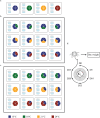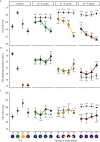Heatwave duration, intensity and timing as drivers of performance in larvae of a marine invertebrate
- PMID: 40335669
- PMCID: PMC12059064
- DOI: 10.1038/s41598-025-98259-7
Heatwave duration, intensity and timing as drivers of performance in larvae of a marine invertebrate
Abstract
In marine ecosystems, crustaceans face an alarming threat from the increasing frequency and intensity of marine heatwaves as their early planktonic stages are particularly temperature sensitive. While the impact of heatwaves on adult crustaceans is well-studied, their effects on larvae remain underexplored. This study focuses on heatwave effects on larvae of the European shore crab, Carcinus maenas. Through a factorial experiment, larvae were exposed to different heatwaves of varying onset timings, durations, and intensities. Survival, development duration, and dry mass decreased under intense heatwaves, with more severe effects observed when heatwaves occurred later in development, highlighting a stage-specific sensitivity to heatwave. We also identified a "region of existence" beyond which larval performance was compromised compared to baseline temperatures. This region defines the heatwave components considered "extreme" for the organism, as well as those inducing neutral or positive effects on performance. Additionally, we distinguished heatwave effects (characterised by their components) from those attributed to the average temperature experienced during the experiments. Our findings demonstrated that larval performance was lower during intense heatwaves compared to the performance expected under a constant average temperature. These findings emphasize the importance of considering heatwave timing relative to the life cycle for predicting marine population responses to climate change.
Keywords: Carcinus maenas; Global warming; Larval performance; Marine heatwaves.
© 2025. The Author(s).
Conflict of interest statement
Declarations. Competing interests: The authors declare no competing interests. Ethical approval: The research presented in this paper complies with the German and international laws (guidelines from the directives 2010/63/EU of the European parliament and of the Council of 22nd September 2010) on the protection of animals used for scientific purposes.
Figures








References
-
- Rama, H. O. et al. Climate Change 2022: Impacts, Adaptation and Vulnerability Working Group II Contribution to the Sixth Assessment Report of the Intergovernmental Panel on Climate Change. 10.1017/9781009325844 (2022).
-
- Meehl, G. A., Tebaldi, C. M. & Intense More frequent, and longer lasting heat waves in the 21st century. Science305, 994–997 (2004). - PubMed
-
- Perkins, S. E., Alexander, L. V. & Nairn, J. R. Increasing frequency, intensity and duration of observed global heatwaves and warm spells. Geophys. Res. Lett.39, 2012GL053361 (2012).
-
- Frölicher, T. L. & Fischer, E. M. Gruber, N. Marine heatwaves under global warming. Nature560, 360–364 (2018). - PubMed
MeSH terms
LinkOut - more resources
Full Text Sources

